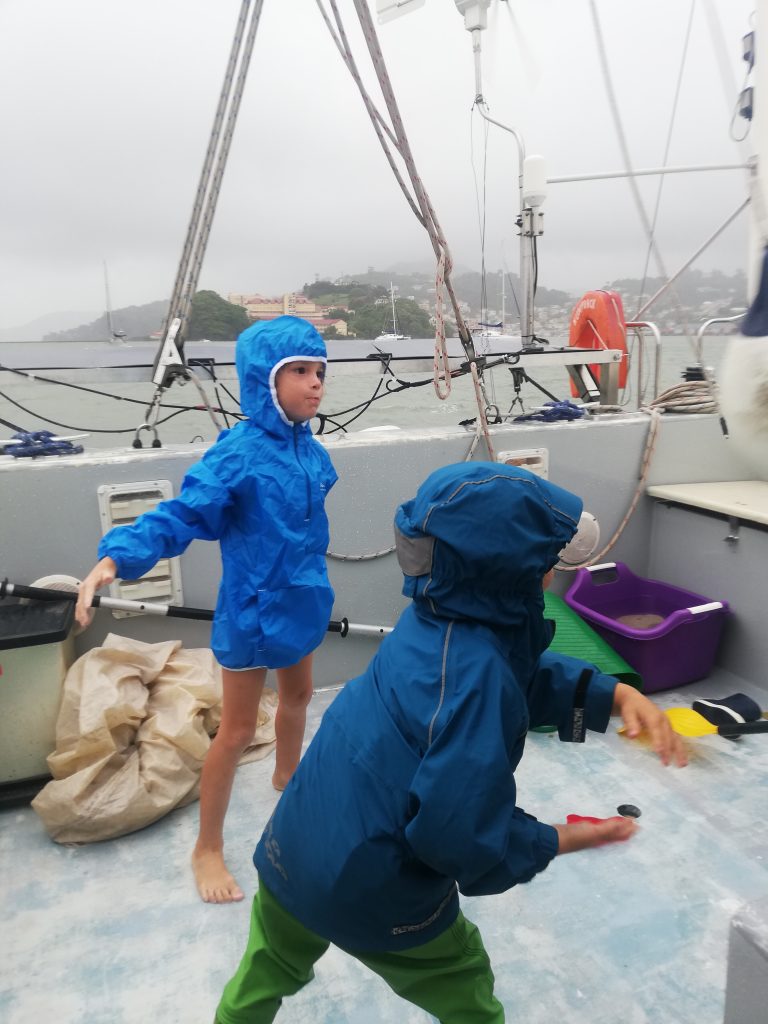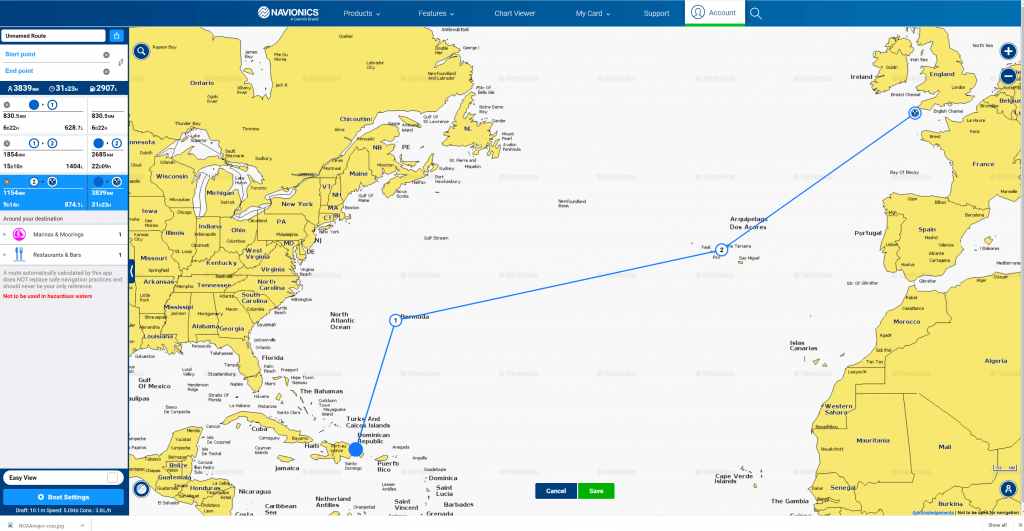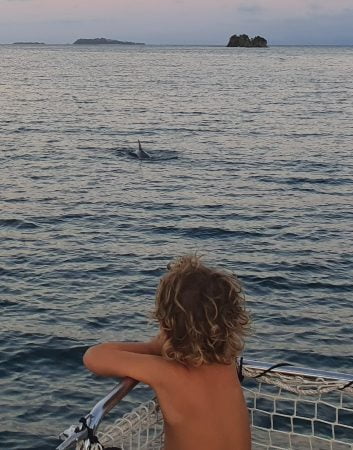It’s that time of year again. The boys are role-playing tying up boats in the mangroves, I’m vacillating between anxiety and contentment (mostly the latter) and Dave is…well normal Dave, completely relaxed after doing his research. We are entering hurricane season. Or, as the local people here call it, “Summer”. The decision of where to spend this year’s season was considerably more difficult than last year’s due to COVID-related restrictions on movement (and potential future restrictions), which have really limited our potential options. So, what next for SV Humpback?

Map refers to flight restrictions but is indicative of those imposed on travel by sea
https://www.iatatravelcentre.com/international-travel-document-news/1580226297.htm
Typically, there are a number of options for hurricane season, which runs officially from June-November: you leave the area entirely, perhaps to somewhere in the region considered out of the hurricane ‘box’, or further afield; you choose one of the areas on the periphery of the hurricane zone, monitor the forecasts and be willing to move if you’re at risk; you have your boat hauled out, in many cases strapped down, maybe flying somewhere else; you continue to cruise any of the islands, monitor the forecasts and at the slightest chance of risk set sail to a safer place. With accurate five-day warning cones on developing storms, it’s feasible to make a move and be out of harm’s way if anything heads in your direction, but this does involve being on constant stand-by, being adequately fuelled and provisioned for a few days travelling, and relying on encountering no boat issues that would mean progress to safety is stalled. Not ideal for us.
Many Caribbean cruisers, due to restrictions put in place due to COVID, are currently in areas that are not considered safe during hurricane season; normally, most would move on. Last year, like hundreds of cruisers, we did just this, anchoring in Grenada from August before spending October and November in St. Vincent and the Grenadines, then St. Lucia. However, with many borders still closed, and others only recently reopening, we haven’t been keen to do the same. The ‘second wave’ of COVID could impact us significantly if we chose to move locations, only for the country to then reimpose restrictions.




Grenada has re-opened its borders and has a very comprehensive plan in place for cruisers wishing to spend the season there, but previously the lock-down restrictions were pretty stringent, with extensive queuing at supermarkets and strict monitoring of the activity of cruisers. Lockdown here in Samana has been fairly relaxed in comparison, with a more moderate impact on our daily lives than would have been the case elsewhere. And as well as the potential for such day-to-day restrictions, with a fluid border situation we may be prevented from entering other countries on the hurricane season ending- who knows how the COVID situation will have developed between July and November?
As an alternative to remaining in the Caribbean, many Americans and Canadians are making the journey back home as the weather conditions allow, not a small feat when you consider that, ideally, they’ll be making minimal stops en–route, and quarantine measures at any stops may restrictive. Given that the weather around Florida has been pretty volatile during late May/early June, this has certainly not been an easy ride. For non-American citizens wishing to remain in the Caribbean area, Panama is an option (with a 14 day quarantine period on arrival), and we would have considered Guatemala as originally planned had the border there re-opened around May-time, and there been no chance of them being re-imposed while we were en-route, around a 10 day sail from here. But with the border remaining closed, that option wasn’t open to us, and we don’t want to make the journey later in the year due to the potential for severe weather and a lack of sheltered spots if we encounter adverse conditions.
Could we return to the UK, just as US and Canadian citizens are heading home? Perhaps, but it wouldn’t be ideal. By plane (if I could convince Dave to fly in the first place!), we could stay with family until we could return to the boat, but this would mean months of paying to leave our boat in a Caribbean marina whilst waiting for the season to end, relying on being able to return at all given changing travel restrictions, as well as there being potential financial implications for leaving an asset such as a boat. We could pay for the boat to be carried by ship across the Atlantic whilst we return by plane, but the expense and uncertainty of when we could start traveling again would be stressful. So that leaves sailing back, but roughly 3,800 miles with potential but limited access to provisions in Bermuda and the Azores does not sound appealing. We’d have little time to get the boat in order (we have A LOT of jobs to complete before we were comfortably with another long crossing) and provision adequately (although Dave has suggested that we are better provisioned now than we were to cross the Atlantic- I’m starting to agree!). Oh, and did I mention that the kids would be difficult, especially with Hector being so mobile and inquisitive but without a solid understanding of risk and consequence, as well as the two-week quarantine period at the other end being more than a little unappealing.

Not that returning to the UK doesn’t have its appeal. We all miss family, and the fairly regular visits we’ve enjoyed up until recently have been wonderful- we can share a little slice of our lives with visitors, and the kids enjoy extended bonding time, building memories and sharing experiences in a way that just isn’t possible over video call and messaging. With travel restrictions and health concerns related to flying, Nana B was forced to cancel her planned visit in March, and it isn’t possible for any family member to arrange anything until the uncertainty clears. Which could be a long time. The cost implications for visitors are also prohibitive, so an extended stay back in the UK would be an opportunity to reconnect and share some family time whilst our sailing plans are effectively on hold anyway, though with social distancing restrictions I’d much prefer to time a trip back when we could actually hug our relatives and travel between them without worrying about cross-infection risks! With all this uncertainty, it feels less disruptive for all of us to remain on the boat in the Caribbean.








In the end, we have opted for staying here in the Dominican Republic for the season. The island is right in the middle of the hurricane ’box’ if you look at the map. One option, assuming the Navy allows it, was to go to Luperón, known as one of the best hurricane holes in the world. It’s not a long sail from here to there and the harbour is very sheltered (great!), but reputedly not great for swimming. With the current COVID restrictions, as well as limited access to land, in Luperón we also wouldn’t be able to play or exercise in the water, so it’s not where we would want to be long-term. We briefly considered the idea of planning to sail around if a serious threat was forecast, but keeping the boat in a constant state of readiness (everything stowed, the cockpit tidy and the lines prepared for sailing at short notice) would be stressful in itself! And unless Dispatchoes are being issued, we wouldn’t be able to travel to Luperón with the official paperwork. If a storm was forecast, we’d be offered shelter, but might be asked to leave the Dominican Republic when it was safe to do so. And in this situation, we wouldn’t have many options for our next destination.
After Dave has done some more research on hurricane tracks and I have spoken with the Dominicana locals, we don’t feel the need to move on. We’ll stay right here in Samaná. As hurricane preparation, we were told that some of the local boats sail over the bay to the Los Haitises National Park, travel up the river into the mangroves and leave the boats secured as best they can whilst they shelter on shore. It’s a strategy adopted elsewhere in the Caribbean and would leave the boat in a sheltered spot. But given how isolated things are over there, not ideal! On speaking to the harbour master, the mangrove strategy would only be necessary when there is very heavy wind from the East, which looking at previous weather and the geography around here is very unlikely. Instead, we have opted to pay for a mooring from July to October. It is only a few hundred metres from our current location, but the water quality isn’t ideal (it’s further into the enclosed bay and shallower so gets churned up)- as we wouldn’t want to swim off the boat, we will remain anchored in our current location and relocate to the mooring if heavy weather is forecast.


Dave was given the opportunity to borrow a dive tank and dive the mooring before we made the decision- it’s a huge concrete block, with a chain riser about double the size of our anchor chain, attached to well-maintained and vastly-oversized (for our boat) warps. Add to that, Domingo, who manages the moorings, dives to add an enormous extra rope between us and it should severe weather be forecast. Given our boat is only 40’ and something like 6 tons in weight, the mooring will stand up to a lot more punishment than the boat would in heavy weather. We’ll add some additional (oversized and well-supported) fittings to the bow and do what we can to add redundancy. It’s an added layer of security knowing we have an option to leave the boat as securely as we can whilst we go ashore (and if necessary inland) to safety, but leaving our only home exposed to the forces of a potential hurricane makes me anxious. And as we wouldn’t be insured, for damage to our own boat or that caused to other boats by ours, there is still a financial risk attached to remaining here.
Dave works on statistics and ‘chance’- we’ve both been through the numbers and previous storm/hurricane tracks, and he is happy to say, since the likelihood of a hurricane that might damage our boat is <2%, it isn’t worth worrying about. So he isn’t worrying. I understand this perspective, but I’m more of a ‘what happens if this year we are in the <2% chance category?’ kind of person. I can’t forget the devastation we have seen on Barbuda and other islands, land and communities ravaged, and the time it takes for places to recover. I worry about how the boys would respond to being uprooted from the boat to stay on land if a serious storm is forecast, and the impact on them if the town and area they have come to know so well is flooded, damaged or destroyed. I can’t equate all this with Dave’s positive risk assessment. But strangely, on balance this still feels like the less disruptive and most certain option of all.






And it may seem complacent to say this, but it’s just so lovely here that we aren’t ready to leave. The people are friendly, our Spanish is gradually improving (not as fast as I would expect given our time here, but due to COVID we aren’t able to interact so widely), the landscape is stunning and the wildlife varied. We’ve barely had chance to explore more widely than the area surrounding the anchorage, and Dave and the boys have spent very little time absorbing the sights and sounds of the town. Whilst shopping, I’ve had more opportunities to interact with local people and experience the culture. I’ve seen so much to love, and much to make me smile: people steering motorcycles one-handed whilst balancing a tray of 36 eggs in the other hand; on two separate occasions, men motorcycling whilst dragging along the road behind them 5m lengths of rebar; the man who makes a few Pesos by weighing down pieces of cardboard with stones to keep motorcycle seats cool; the man dancing unselfconsciously on the roof of his empty-of-tourists tour boat as it travels across the bay; families of 4 riding two-people motorcycles whilst weighted down with decent-sized grocery shops; the man who walked through town blithely holding a machete after collecting some local fruit (which even to me didn’t seem that weird, despite the fact in the UK I’d be shocked). Everything here feels rich and vibrant and relaxed, and did even at the height of the COVID restrictions. Oh, and we’ve had dolphins swim around the boat in the anchorage a couple of times, and spotted eagle rays leap out of the water around us!

A great way to end the evening!
Based on our current plans, we will be here until at least November when the season ends. Since the town and area are familiar, friendly and beautiful, we think staying for Christmas would be wonderful, and after that the whale season starts, the reason we came here in the first place- what better reason to stay even longer? Hopefully over the next few months we can visit the interior of the island, explore the national park area, try some new beaches and anchorages and support some local businesses that are sure to be struggling given the lack of tourism over the last few months. There is so much we haven’t seen or experienced that we’re not ready to leave. Even despite a potential hurricane.